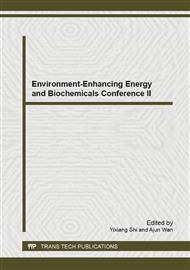[1]
F. Debeaufort, and A. Voilley, Methylcellulose-Based Edible Films and Coatings: 2. Mechanical and Thermal Properties as a Function of Plasticizer Content. Journal of Agricultural and Food Chemistry, 1997. 45(3): pp.685-689.
DOI: 10.1021/jf9606621
Google Scholar
[2]
G. I Olivas, J.J. Rodriguez and G.V. Barbosa-CÁNovas, Edible Coatings Composed of Methylcellulose, Stearic Acid, and Additives to Preserve Quality of Pear Wedges. Journal of Food Processing and Preservation, 2003. 27(4): pp.299-320.
DOI: 10.1111/j.1745-4549.2003.tb00519.x
Google Scholar
[3]
C. Leonelli and T.J. Mason, Microwave and ultrasonic processing: Now a realistic option for industry. Chemical Engineering and Processing: Process Intensification, 2010. 49(9): pp.885-900.
DOI: 10.1016/j.cep.2010.05.006
Google Scholar
[4]
P. Lidström, J. Tierney, et al., Microwave assisted organic synthesis—a review. Tetrahedron, 2001. 57(45): pp.9225-9283.
DOI: 10.1016/s0040-4020(01)00906-1
Google Scholar
[5]
R. Banerjee, H. Chen, and J. Wu, Milk Protein-based Edible Film Mechanical Strength Changes due to Ultrasound Process. Journal of Food Science, 1996. 61(4): pp.824-828.
DOI: 10.1111/j.1365-2621.1996.tb12211.x
Google Scholar
[6]
C. -C. Liu, A.M. Tellez-Garay, and M.E. Castell-Perez, Physical and mechanical properties of peanut protein films. LWT - Food Science and Technology, 2004. 37(7): pp.731-738.
DOI: 10.1016/j.lwt.2004.02.012
Google Scholar
[7]
E. Marcuzzo, D. Peressini, et al., Effect of ultrasound treatment on properties of gluten-based film. Innovative Food Science & Emerging Technologies, 2010. 11(3): pp.451-457.
DOI: 10.1016/j.ifset.2010.03.002
Google Scholar
[8]
E. Ahmadi, S. Sareminezhad, and M.H. Azizi, The effect of ultrasound treatment on some properties of methylcellulose films. Food Hydrocolloids, 2011. 25(5): pp.1399-1401.
DOI: 10.1016/j.foodhyd.2010.08.015
Google Scholar
[9]
İ. Gülseren, D. Güzey, et al., Structural and functional changes in ultrasonicated bovine serum albumin solutions. Ultrasonics Sonochemistry, 2007. 14(2): pp.173-183.
DOI: 10.1016/j.ultsonch.2005.07.006
Google Scholar
[10]
P. B. Stathopulos, G. A. Scholz, et al. Sonication of proteins causes formation of aggregates that resemble amyloid. Protein Science, 2004. 13(11): pp.3017-3027.
DOI: 10.1110/ps.04831804
Google Scholar
[11]
A. Jimenez, M. J. Fabra, et al. Effect of lipid self-association on the microstructure and physical properties of hydroxypropyl-methylcellulose edible films containing fatty acids. Carbohydrate Polymers, 2010. 82(3): pp.585-593.
DOI: 10.1016/j.carbpol.2010.05.014
Google Scholar
[12]
A. Jiménez, M. J. Fabra, et al., Effect of re-crystallization on tensile, optical and water vapour barrier properties of corn starch films containing fatty acids. Food Hydrocolloids, 2012. 26(1): pp.302-310.
DOI: 10.1016/j.foodhyd.2011.06.009
Google Scholar


